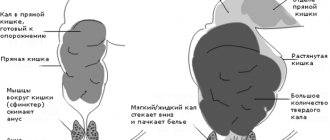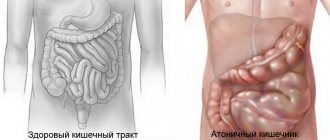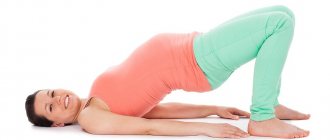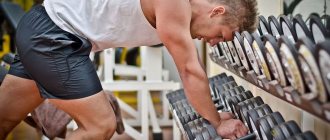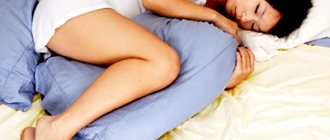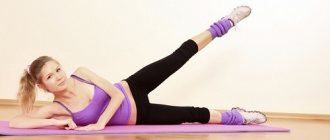Gymnastics for the intestines for constipation
Physical therapy is an essential element of a comprehensive approach to the treatment of constipation. In addition to the strengthening and health-improving effect that gymnastics has on the entire body, it influences the growth of intestinal functionality, its motility and increased blood circulation.
There are special exercises for bloating, to treat constipation, as well as exercises that improve intestinal motility, which helps to naturally cleanse the body of toxins
Forms of exercise therapy for the intestines:
- physiotherapy;
- morning work-out;
- walking;
- traveling by bicycle;
- swimming;
- skiing, etc.
It is best to choose a specific form of physical therapy together with a physical therapy instructor, depending on the individual characteristics of the patient: the form of constipation, its cause, the patient’s physical fitness, age and general condition.
Useful properties of charging
In the process of performing special exercises, a change in intra-abdominal pressure occurs due to increased breathing power, the work of the abdominal muscles, their relaxation and subsequent compression, as well as when changing body position. The change in pressure promotes the movement of feces in the intestines and its complete emptying.
In addition, the regulation of digestion returns to normal:
- processes associated with inflammation of the intestine or its parts stop;
- blood and lymph circulation in the gastrointestinal tract is established;
- the absorption and secretory work of the intestines is streamlined;
- bloating decreases;
- peristalsis improves;
- the body is cleansed of toxins.
Scientists have found that exercise not only improves physical health, but also serves as a preventive measure against colon cancer.
A secondary, but important effect of intestinal gymnastics is strengthening the abdominal and pelvic floor muscles, improving psycho-emotional health.
Treating constipation with intestinal exercises is especially effective when doing the exercises at the same time every day. Normal functioning of the intestines, a state of lightness and relief from abdominal pain comes after at least 2-3 months of regular exercises, but the first results can be felt within a few days.
Features of physical activity
Physical exercises for constipation are no less effective than breathing exercises. Regular exercise, done correctly, helps a person enrich the body with oxygen, speed up metabolism and blood circulation, as well as maintain optimal body weight and improve immunity.
It should also be noted that physical therapy helps not only fight, but also prevent the development of many diseases of internal organs, including constipation and hemorrhoids.
According to experts, the best prevention for intestinal problems is morning exercises. To get rid of constipation, it is advisable to do it on an empty stomach, after drinking clean and cool water (1 glass).
Indications for gymnastics
Therapeutic exercise is especially indicated for neurogenic constipation, in which spasms of the large intestine occur due to existing disorders of the autonomic nervous system.
The goal of physical therapy in the treatment of constipation is to normalize intestinal motor function and eliminate congestion.
Signs of neurogenic constipation are:
- typical “sheep” feces;
- bloating;
- loss of appetite;
- bad feeling;
- abdominal discomfort;
- general decrease in working capacity.
This type of difficulty in defecation is divided into two types:
- With occurring hypokinetic disorders. Peristalsis is reduced, the tone of the intestinal walls is weakened. Constipation is accompanied by aching pain in the navel area.
- With the presence of hyperkinetic disorders. In this case, the intestinal walls have increased tone, are prone to spastic contractions and cause painful colic in the patient.
Video: treatment of constipation according to Bubnovsky
Treatment
Nutrition
Nutritional adjustment is the primary cure for constipation in older people
Change your eating habits if constipation has become your constant companion. Increasing your fiber intake is the first step to relieving constipation. Make it a rule to eat several servings of fresh vegetables and herbs daily. Drink a glass of fermented milk drink in the evening. Eat apples, plums, any available fruits and berries. If the condition of your teeth does not allow you to chew fibrous foods, boil, bake, puree or use a blender. Limit bread made from white flour, yeast and butter baked goods, and rice cereal. A healthy alternative is whole grain, bran bread, oatmeal cookies and porridge, and buckwheat.
Add ready-made fiber from wheat, buckwheat, flax seeds to your food, starting with half a teaspoon and increasing to several tablespoons per day.
Be sure to change your water regime: you cannot limit drinking. Drink clean water, cook compotes from fresh fruits, prunes, raisins. Steam raisins and prunes with boiling water overnight, and add to porridge in the morning. Drink weak tea, alternate with a decoction of rose hips, cherry leaves, and currants.
Exercises for constipation in older people
An inactive lifestyle can harm even a young person. As you age, physical activity becomes an excellent help in slowing down the aging process. Move whenever possible, walk to stores, walk in parks. At home, do simple exercises, turns, bringing your knees to your stomach, as far as your physical condition allows.
Strengthening the defecation reflex
Morning is the time of greatest intestinal activity. Try to train yourself to have a bowel movement after waking up or half an hour after breakfast. When you wake up, drink cold water and massage your abdomen. Sit on the toilet with a low bench under your feet to avoid unnecessary straining. It is preferable to give an enema in the morning.
Possible contraindications and side effects
Structural abnormalities in the intestines are a direct contraindication to therapeutic exercises. Organic changes are a mechanical obstacle to the passage of feces, and in this case physical education is powerless. Such pathologies include:
- development of adhesions in the intestine;
- tumors of any nature;
- scarring;
- malformations: megacolon - enlargement of the entire colon or part of it;
- dolichosigma - gigantism of the sigmoid colon.
In addition to the above, general contraindications are:
- increased body temperature;
- severe heart disease;
- infectious or inflammatory processes;
- purulent dermatitis and skin and venereal diseases.
Some pathological processes are a contraindication to physical therapy
Exercising for constipation is an ideal treatment option for people who have no contraindications to physical activity. Physical therapy is a more healing method of treatment, which, unlike medications, has no side effects.
Causes of constipation in older people
- The nature of nutrition changes. Refined, easily digestible foods, without fiber, begin to predominate. This fact is due to problems with teeth, insufficient production of saliva, and stomach diseases. Mental disorders, forgetfulness, and inattention cause a decrease in appetite up to complete skipping of meals. The economic factor plays a sad role; people are forced to buy cheap food, impoverishing their diet.
- Motor activity decreases. Sore joints, pressure surges, and fatigue interfere with full movement. The older age group is characterized by an increased risk of diseases leading to disability and a sedentary lifestyle.
- Presence of concomitant diseases. Hemorrhoids, intestinal tumors, endocrine pathologies (hypothyroidism, diabetes mellitus), Parkinson's disease, depression, strokes directly or indirectly slow down the movement of feces.
- Taking a number of medications that promote consolidation of stool. The list is extensive: antacids, calcium derivatives, non-steroidal anti-inflammatory drugs, antiallergic drugs, diuretics and others.
- Drinking small amounts of liquid. With age, some patients develop urinary incontinence. In an effort to prevent such a nuisance, a person limits himself to liquid, especially at night. The stool becomes dense and lingers in the intestinal lumen for a long time.
Preparation for exercise therapy
Gymnastics for the intestines should be carried out on an empty stomach - either an hour before a meal, or two hours after.
Before performing the exercises, light preparation is recommended, focusing on the abdominal muscles. This warm-up can take place right in bed after waking up; it serves as stimulation to go to the toilet in the morning and accustoms the body to a certain bowel movement routine.
Morning exercise complex:
- Abdominal massage: lying on your back, lightly pressing your palm on your stomach, stroke it clockwise around the navel, making a total of 10 circles.
- Rubbing the abdomen with the lower part of the palm near the navel for a minute.
- Raise your right leg, bend it at the knee and press it to your stomach with both hands, hold it for half a minute. Slowly change legs and do the same with your left leg.
- Slowly get out of bed, first with your right leg.
After warming up, you should drink a glass of warm water and after a quarter of an hour you can begin the main part of the gymnastics.
Which exercises are best?
In fact, any physical activity has a beneficial effect on the intestines. Therefore, it is not necessary to stick to any specific exercises.
To get rid of constipation, you can do physical exercise not only in the gym, but also at home. To improve the quality of bowel function, you should tilt your torso (left, right, forward, backward), as well as make rotational movements of the pelvis and body as a whole (clockwise and counterclockwise).
Abdominal pumping, squats, jumping rope, marching in place, etc. also help with constipation.
When performing all these exercises conscientiously, you should remember that the first few workouts will not produce any effect. A complete cure for regular constipation can be achieved only with regular physical activity.
If the problem in question has become more complicated and you have hemorrhoids, then experts recommend walking or jogging more often. Such exercises help strengthen the abdominal and abdominal muscles, as well as increase blood flow. By the way, in the winter, if you have a similar problem, you can go cross-country skiing.
Physical therapy complexes at home
Depending on the type of constipation, the most productive gymnastics complex is selected.
Complex for hypokinetic disorders
For constipation caused by weak intestinal motility, it is recommended to perform exercises that develop the strength of the abdominal muscles through proper loading and the inclusion of strength elements, as well as the use of various weights.
The set of exercises should be performed at an average pace, the starting positions may be different, the program includes squats, jumping and running.
Each exercise is performed repeatedly, especially recommended approaches that have directional movements, which help speed up bowel movements.
Video: a set of exercises for atonic constipation
https://youtu.be/YRVN-laOnVY
Exercise techniques for adults
Exercises for atonic constipation are performed at a normal average pace with a fairly large number of repetitions
- Initial position (v.p.) lying with your back on the floor, hands on your waist, legs fixed on a gymnastic bench (or your legs can be held by a partner). We do approaches for the abdominal muscles: we move from a lying position to a sitting position and return back, a total of 20 times.
- N.p. the same, arms along the body, a gymnastic ball is fixed between the feet. On the count of one, we raise our straight legs up, on the count of two, we bend our knees, on the count of three, we lower our legs to the starting position. We perform 15 approaches.
- N.p. lying on your back, holding a gymnastic ball in your hands. We move from a lying position to a sitting position and back, without straightening our arms and without using the force of inertia; we only need to use the abdominal muscles. We do 10 repetitions in total.
- N.p. sitting on a chair. We alternately rotate the body to the left and right while simultaneously abducting the corresponding arm, 10 approaches on each side.
In case of hypokinetic disorders, general strengthening exercises and approaches for developing the strength of the abdominal muscles are important.
- N.p. the same, hands are located on the belt. We alternately tilt the body to the right and left, 10 times on each side.
- N. standing, arms in front of the chest bent at the elbow joint, legs shoulder-width apart. The pelvis is fixed in place, we perform turns only with the body, each time forcefully spreading our arms to the sides. We perform 10 approaches on the left side, 10 on the right.
- N.p. Same. Exercise “mill”: tilt the body forward and alternately stretch the opposite hand to the foot, a total of 15 times.
- N.p. remains unchanged. We perform rotations with the body, while the pelvis is in a fixed position. We make 8 circles in one direction and the same in the opposite direction.
Complex for hyperkinetic disorders
For spastic constipation, the choice of the starting position in each exercise is especially important, since such gymnastics should provide relief from intestinal spasms. The abdominal muscles should be relaxed, so it is recommended to limit abdominal exercises. The initial positions before each exercise should be conducive to relaxation of the abdominal wall, and during the performance of gymnastics there should be a moment of directed effort: simultaneous raising of the legs, “bicycle” and the like. Therapeutic exercise for hyperkinetic phenomena in the intestines is similar to gymnastics for neurological problems, for example, osteochondrosis.
Video: exercises to get rid of spastic constipation
Exercise techniques
When hyperkinetic phenomena predominate, great attention should be paid to the choice of starting positions that promote relaxation of the anterior abdominal wall
- N.p. — lying with your back on the floor, limbs extended. We raise our legs one by one, bent at the knee, and press them with both hands to the stomach. We perform 10 approaches on each leg.
- N.p. the same, hands pressed to the floor. Without bending in the lower back, we alternately raise our straight legs up, forming a right angle, 10 times.
- N.p. the same, hands behind your head. Raising your straight leg up, move it to the side diagonally and return it back. We perform 10 approaches with the right leg, then the same number with the left.
- N.p. do not change, hands along the body. We raise our legs bent at the knees and do the “bicycle” exercise. At the same time, we press the lower back to the floor to remove excess load from the spine. Ten repetitions clockwise and the same counterclockwise.
For spastic constipation, it is important to alternate exercises on muscle groups and relaxing ones.
- N.p. On knees. As you exhale, sit on your heels and inhale, returning to the starting position, 15 times in total.
- N.p. Same. Straighten your right leg, sharply moving it back, then press it to your stomach. Afterwards we repeat the swings with the left leg, 15 times.
- N.p. lying on your back, hands behind your head. We bend our legs at the knee joints and lower them to the right, the pelvis follows the legs, and the shoulder blades remain pressed to the surface. Then we move the legs with the lower half of the body to the left, performing 15 full turns in total.
- N.p. lying on your back, hands on your chest. We alternately bend our knees, 10 times on the left and right legs.
Depending on the general well-being of the patient, age and level of physical fitness, you can change the number of approaches to the exercises. To begin with, you can do 6 repetitions at each stage of the complex.
Swimming
It is worth emphasizing that swimming has an equally good effect on intestinal motility for any type of constipation that is not associated with organic pathologies. While in the pool, the abdomen is massaged, all muscle groups work, without creating unnecessary stress on the spine. The therapeutic effect of water leads to normal intestinal motility and helps speed up the process of defecation. Swimming daily creates a constant bowel movement routine.
Swimming helps relieve infant colic and constipation in children.
Breathing exercises
Breathing exercise is a way out of this situation. This gymnastics is effective for the prevention and treatment of diseases of the digestive system. Recommended for women with advanced pregnancy, elderly people who are prohibited from physical activity, and for bedridden disabled people.
With simple techniques for regulating breathing, you can bring your digestive system back to normal without medication. This technique is better absorbed in a horizontal position in a calm environment. The person calms down, relaxes and feels his own breathing.
- Place your palm on your stomach and exhale so that the abdominal wall is drawn as close to the spine as possible.
- After this, inhale, while the abdominal cavity should rise as high as possible.
- The palm monitors the breathing process. As soon as your palm drops, you immediately need to inhale with your stomach.
- It is recommended to learn to breathe correctly while lying down, and at the last stage while standing.
Intestinal disease is a problem that reduces various aspects of life. It has a negative effect on the condition of the entire body. The main factor affecting the digestive system is regular physical activity. Due to the effect on the abdominal walls of the abdomen, the smooth muscles of the intestines contract, which helps in the elimination and prevention of the disease. Don't be lazy - constant exercise will not only cure diseases, but also tighten your abs, increase muscle tone and increase vitality. Physical labor is also effective against constipation.
Therapeutic exercise helps to restore lost health, eliminate disease, and bring the basic systems of the body into operation. In addition, gymnastics develops moral and volitional qualities in a person, instilling a sense of responsibility for one’s health. Gymnastics is recommended for patients for whom drug treatment of this disease is contraindicated. Statistics show that exercise therapy can help even with chronic constipation in adults.
Exercises for constipation help not only speed up the process of bowel movement, but also improve the quality of bowel function. We will talk further about what kind of physical activity a person needs with such a problem.
Walking
If we evaluate the effectiveness of many exercises that are suitable for older people suffering from constipation, then ordinary walking remains one of the most relevant and effective. It is enough to walk 3-5 km at a normal walking pace per day.
Staying in the fresh air, combined with such simple physical activity, has a complex effect on the human body. Elimination of constipation in older people in this case occurs due to:
- Activation of gastrointestinal motility. The anterior abdominal wall constantly contracts during movement and has a similar effect on the large and small intestines.
- Strengthening lung ventilation. They expand more than usual, which puts additional pressure on the diaphragm. It, in turn, also contracts and gently massages the intestinal loops from above, providing stimulation of their own motility.
- Strengthening microcirculation. Regular walking, like any other physical activity, ensures a flow of fresh blood to almost all organs and systems, enhancing their functional activity. This is also true for the intestines.
In addition to its positive effect on gastrointestinal motility, walking is especially important for older people due to its ability to stabilize blood pressure, reduce sugar levels and “bad” cholesterol in the blood.
Since very often people over the age of 60 have certain problems with metabolism, the natural opportunity to improve their health through regular walking is a simple and affordable method of normalizing well-being.
Causes
The main reason is associated with a decrease in muscle tone of the intestines - this is called intestinal atony. It develops during the process of physiological aging. The rectum is no longer as sensitive as it used to be and cannot send signals to the brain that it is time to go to the toilet.
Constipation is often a symptom of illness or indicates an unhealthy lifestyle that needs to be corrected.
Constipation is typical in the following cases:
- Thrombosis occurs when the blood vessels supplying the intestines become blocked. Intestinal obstruction develops due to tumors, adhesions, and diverticula. Acute stool retention occurs, which is accompanied by bloating, pain and gas formation;
- Violation of a healthy diet and lack of fluids, due to which episodic stool retention develops;
- Diabetes;
- Obesity;
- Reduced functionality of the thyroid gland;
- A diet low in fiber and high in simple carbohydrates;
- Frequent stress;
- Untreated or poorly treated intestinal diseases;
- Atherosclerosis of the arteries that feed the intestines;
- Passive lifestyle;
- Taking certain medications. These include iron-containing, painkillers, diuretics, anticholinergics, antidepressants, drugs for epilepsy, sorbents;
- Previous operations in the abdominal area;
- Infection with helminths.
Constipation in older people can also develop due to intestinal spasms. Spasms can be caused by poor nutrition, food allergies, frequent stress, helminths, and intestinal infections.
The following symptoms indicate colon spasms:
- Long constipation, then diarrhea;
- Pain in the lower abdomen;
- Discharge from the anus of mucus and gas;
- Painful bowel movement;
- Feces come out with mucus in small pieces;
- Insomnia.
The third reason is a tumor in the colon. Signs of a tumor are similar to intestinal spasms.
Treatment for constipation will depend on the cause that caused it. For correct diagnosis and treatment, you should contact a gastroenterologist.
Self-massage
Basic rules and recommendations. You can massage yourself in any conditions and at any time. However, when performing massage movements you need to follow certain rules:
- the body should be as relaxed as possible; it is best to do the massage in a lying position on a comfortable bed or sofa;
- massage is done only on clean skin and clean hands;
- It is best to place a woolen cloth between the hands and the skin of the abdomen;
- After a snack, at least half an hour should pass, and after a hearty lunch - at least an hour and a half.
Execution technique. Self-massage of the abdomen is performed clockwise, starting from the right iliac region. First, stroke with an open palm, then perform circular movements with the base of the palm. It is very useful to follow the same “route” with the palmar surface of the fingers. Focusing on your own sensations, you can do intermittent pressure, shaking and jerking movements. It is important that everything is done without jerking, slowly, calmly and gently. If you feel intestinal peristalsis under your palms, you need to help this, as if pushing the intestinal contents in the right direction.
Self-massage
It is advisable to combine strength training and massage elements. It will help improve the functioning of the entire gastrointestinal tract. The movements are simple; no special skills are required to perform them. It is better to do self-massage in the morning. It consists of the following elements:
- stroke the stomach in a clockwise circular motion;
- stretch your feet. You can use a massager;
- massage your fingers;
- using a damp cloth, stroke the stomach from bottom to top.
https://youtu.be/Jbp0T7ARQbo
Reforming food
1. Drink enough water - at least 1.5–2 liters per day. This will help soften the stool.
2. Try to establish small meals (4-5 times a day), while eating slowly, chewing food thoroughly.
3. Avoid dry snacks. Try to introduce more fiber into your diet, switch to bread with bran, and add wheat bran when preparing dishes.
4. Eat at least 500 g of fresh fruits and vegetables daily. Try to eat as many beets as possible in any form. This root vegetable perfectly stimulates the intestines. Try to eat salads made from fresh and boiled vegetables every day, seasoned with unrefined vegetable oil. It acts as a lubricant, making bowel movements easier.
General information
What exercises help best with constipation? Before answering this question, we should tell you what this problem actually is.
The process of disruption of normal blood circulation in the rectal area often leads to the fact that a person begins to experience pain, heaviness and itching in the anus. Over time, going to the toilet turns into torture, as unbearable pain and even bleeding appear during the act of defecation.
According to experts, a person can be tormented not only by daily constipation, but also by weekly constipation. This condition is fraught with intoxication of the body, as well as the formation of hemorrhoids.
Bowel exercises for constipation help quite well. But this is only if such classes are held regularly. In addition, to prevent the development of this problem, a person needs to eat right, lead an active lifestyle, etc.
Why does constipation occur? There are a huge number of reasons for this phenomenon. Most often, constipation occurs due to a lack of fluid in the body. Difficulties with bowel movements can also arise as a result of poor nutrition and a sedentary lifestyle.
What causes problems with bowel movements
Constipation is divided into several varieties, which differ in the characteristics of their manifestation and the cause of their development. Many factors can provoke difficulties with emptying, so you should look for the exact trigger of the occurrence together with a specialist.
The most common reasons for the development of constipation include:
- maintaining a passive lifestyle;
- non-compliance with diet;
- improper diet;
- taking medications;
- stress and physical fatigue;
- dehydration;
- presence of bad habits (alcohol, smoking, etc.).
More serious factors that provoke intestinal dysfunction include malfunctions of the pancreas and pathological processes in the intestinal cavity. Thus, constipation can be caused by pancreatitis, gastritis, the formation of adhesions and polyps in the gastrointestinal tract, as well as endocrine disorders.
Chronic constipation can be caused by hormonal imbalance and cholecystitis. In newborns, problems with emptying are observed with the introduction of complementary foods and a sudden change in diet. In older people, constipation develops due to a decrease in intestinal muscle tone and peristalsis, as well as due to the appearance of many diseases associated with old age.
Precautions
Despite all the effectiveness and safety of training to normalize intestinal function, you need to understand that there are situations in which it is worth limiting physical activity. These include:
- uncontrolled arterial hypertension;
- severe forms of ischemic heart disease;
- recent myocardial infarction or stroke;
- suffered severe injuries;
- general serious condition of the patient.
In any case, you should consult your doctor about the advisability of physical activity.
Swimming
Swimming and water aerobics are the most effective methods for relieving any type of constipation in older people. Water procedures are a universal physical activity that allows you to strengthen the entire body and improve the functioning of the gastrointestinal tract.
The main positive effects that this type of activity has on the human body remain:
- Mild stimulation of intestinal motility. Water itself acts as a kind of massager. In combination with the involvement of all muscle groups, it is possible to quickly solve the corresponding problem.
- Toning the whole body. During swimming, almost all muscles work. Against this background, energy consumption increases. To provide the body with nutrients, food processing processes are activated in the intestines, accelerating its evacuation.
- Lung development. They swell more strongly and gently massage the diaphragm and intestines.
In addition, swimming is an excellent anti-stress factor, which will normalize not only somatic, but also psychological health of a person. That is why it is recommended to almost all people, regardless of age.
To eliminate constipation, it is enough for an elderly person to visit the pool at least 1-2 times a week.

